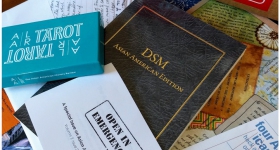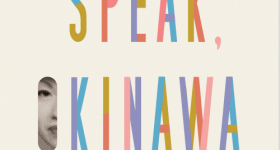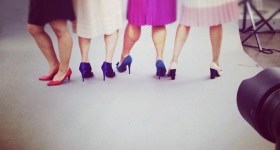Photo: San Francisco schoolchildren say the Pledge of Allegiance, April 1942. Image credited to Dorothea Lange; retrieved here.
When I wrote my first post for Hyphen, Talking Mixed-Race Identity with Young Children, I was deliberately blunt about race. I wrote about how I don’t tell my multiracial son, who presents as a racial minority, that he’s white -- but I do tell him he’s Asian. While the essay resonated with many people, others made comments like this:
“Your child is as white as he is Asian… Why embrace one label and not the other?”
“Why is he Asian but not white? He has white ancestors as much as Asian ones. So if it's OK to call him Asian, it's OK to call him white. Or, if it's not OK to call him white (because he's not completely white) then it's not OK to call him Asian, because he's not completely Asian either.”
“Your child is neither white nor Asian. I once heard this description: When you have a glass of milk and add chocolate to it, you no longer have just a glass of milk and you no longer just have chocolate because you have created something completely different. A bi-racial or multi-racial child is not either/or.”
In the 1990s, psychologist and mixed-race scholar Maria P.P. Root wrote the famous Bill of Rights for People of Mixed Heritage, stirred by her examination of mixed-race identity, interviews with hundreds of multiracial folk across the U.S., and the struggles multiracial people face in forming and claiming a positive sense of self. “I have the right not to justify my existence to the world,” it reads. “To identify myself differently than strangers expect me to identify. To create a vocabulary about being multiracial or multiethnic.”
Almost two decades later, these proclamations still ring so true. Some people are completely unwilling to honor my family’s choice to identify as mixed-race and Asian because it doesn’t align with their own ideas about how we should identify. The right of a mixed-race person to self-construct and self-define, even today, endures continual policing from people with their own agendas.
“If it’s not OK to call him white…then it’s not OK to call him Asian"; "Your child is neither white nor Asian." These critiques are so often centered on whiteness: a sense of disbelief that I would “deny” it to my son, and the conviction that, if I won’t teach him he is white too -- or at least partly white -- then he is nothing at all. Even the problematic chocolate milk analogy -- which the commenter clearly thought was progressive -- begins with a glass of white milk with “color” added. White is seen as normative, and there is a total failure to recognize that racial categories are political.
Of course I talk to my son about our white family members who are a part of his life and his identity. But those stories are about growing up in Virginia, or window candles at Christmastime in New England, or his Slovakian great-great-grandmother who came through Ellis Island alone when she was sixteen. Those stories are about our history, not about being “white.” “White” is not an ethnic celebration, a food festival, or a heritage parade. It’s about having unearned power and privilege based on the way you look.
In Dr. Peggy McIntosh’s famous essay on white privilege, she listed a series of unearned privileges white people enjoy. Among them: “I can if I wish arrange to be in the company of people of my race most of the time”; “I can turn on the television or open to the front page of the paper and see people of my race widely represented”; “I can speak in public to a powerful male group without putting my race on trial”; and “I can be pretty sure that if I ask to talk to the ‘person in charge,’ I will be facing a person of my race.” Are any of these true of my multiracial Asian son? My son, who barely has any children’s books that reflect his racial image, who is constantly scanned and assessed aloud based on “how Asian” he looks, my son who has had many more white teachers than teachers of color?
Telling my child he’s white also won’t help him understand why children who were less than one-quarter Japanese were interned during World War II; why a stranger would look at him and say there are no “pure races” anymore; why a leading theatre company in our city unabashedly staged a yellowface production of an operetta; why kids on the playground pull back their eyes in a slant and spit out one of those ridiculous anti-Asian chants that just won’t go away. When I tell my son that he is Asian, mixed-race, multiracial, and a person of color, I’m not denying him parts of his ancestral-ethnic heritage. I'm teaching him about the race politics that intrude upon our lives whether we want them to or not. I’m preparing him to exist in a world that obstinately persists in being racially divided. And I’m trying to let him know something about the ways he has and will continue to be judged throughout his life, not because he’s white -- but because he’s mixed with color.
***
Sharon H. Chang is writing a book about multiracial Asian children. She has an M.A. in Human Development with an Early Childhood Specialization, writes for ParentMap Magazine and Racism Review, and maintains the blog Multiracial Asian Families. Sharon lives in Seattle with her 100% mixed-race husband and mixed-race son.









Comments